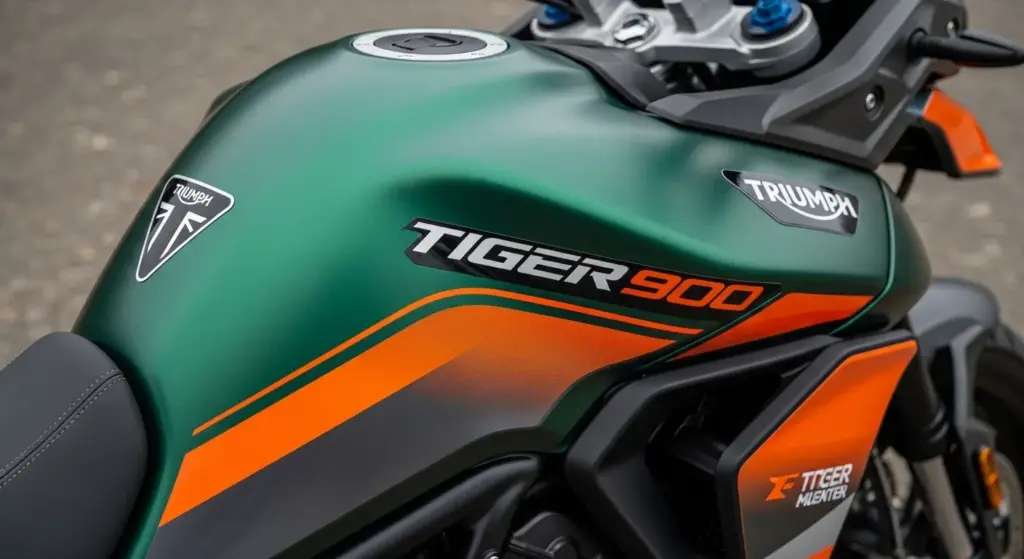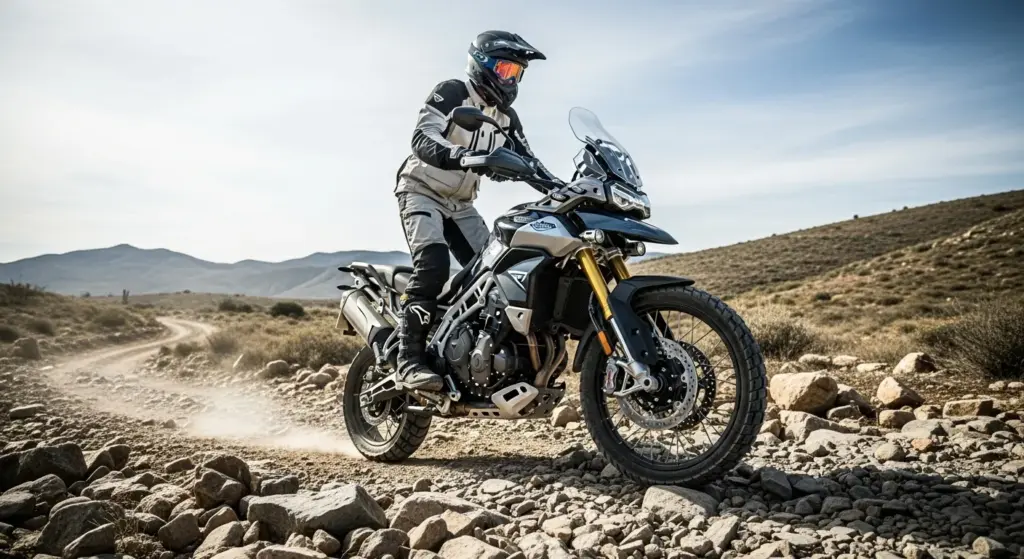Something quietly confident is happening inside Triumph’s Hinckley factory.
While much of the motorcycle world shouts about radical redesigns and power bumps, Triumph seems content to polish what already works. The 2026 Tiger 900 Rally is proof that not every update needs fireworks to matter. It’s a textbook case of measured evolution — the kind of refinement you notice not on a spec sheet, but in the seat, on the throttle, somewhere far from pavement.
This is Triumph’s way of saying, “We’re listening, not overreacting.”
And that subtle philosophy might be what keeps the Tiger 900 Rally at the top of its game for another few years.
The Real Reason Behind the Update
Triumph could have gone louder with its midweight adventure line — a full redesign, new displacement, or a headline-grabbing electronic overhaul. Instead, it doubled down on real-world usability. Riders who live on dirt tracks, or commute daily with a packed pannier, rarely ask for more horsepower; they ask for fewer distractions and cleaner feedback.
That’s exactly what Triumph focused on for 2026. Beneath the familiar silhouette, engineers have tweaked the Rally’s breathing, refined the ride-by-wire throttle mapping, and recalibrated suspension responses to make the motorcycle more communicative on mixed surfaces.
The updates are subtle. Intentional. The kind of adjustments that don’t shout “new model,” but whisper, “trust me, you’ll feel it.”
You should also read this article : Triumph vs. Royal Enfield: A British Motorcycle Brand Stand-off
Design: Minimal Changes, Maximum Presence

At first glance, you’d be forgiven for thinking nothing’s changed. But the 2026 Tiger 900 Rally is a study in restraint.
Triumph’s designers understand that the Tiger’s form — narrow waistline, tall stance, and balanced proportions — has already found its sweet spot. So, instead of re-sculpting, they re-sharpened.
The new color schemes — most notably the Snowdonia White & Graphite and Carbon Black & Yellow Accent — do something rare: they make the bike look both tougher and more premium without gimmicks. The matte finishes carry a muted confidence, and the contrast detailing on the tank and beak gives the Rally Pro variant a distinctive road presence that photographs beautifully in natural light.
Triumph has also quietly improved component finishing. The handlebar clamps, levers, and pegs now wear slightly more corrosion-resistant coatings — small details, yes, but they speak to longevity. For an adventure bike that often sees weather extremes, this matters more than a reshaped fairing ever could.
It’s the kind of upgrade you appreciate in the fifth year of ownership, not the first week.
The Familiar 888 cc Triple — Now Tuned With Intent

Underneath it all sits the same 888 cc inline-three, and that’s a good thing. Triumph’s T-Plane crank engine remains one of the most characterful powerplants in the segment — part twin, part triple, and entirely its own personality.
For 2026, Triumph didn’t change the displacement or layout but re-tuned internals to extract smoother torque delivery and better heat management. Revised intake ports and a freer-flowing exhaust system make the mid-range more responsive, while a slight ECU update smooths out the power pulse during on-off throttle transitions — a common rider complaint on the 2024 model.
The official numbers still hover around 106 horsepower and 66 lb-ft of torque, but those figures only tell part of the story. What you feel is a more linear surge between 4,000 and 8,000 rpm — that zone where most real-world riding happens. The throttle feels less abrupt in technical sections, yet quicker to respond on open highway stretches.
Triumph’s engineers call it “ride feel optimization.” Riders will just call it smoother.
You should also read this article : New Harley 400cc Leaks Hint at a Rebel-Killing Entry-Level Cruiser
Suspension & Control: The Invisible Refinements
No fancy acronyms, no reinvented geometry. The Showa long-travel suspension — 240 mm up front, 230 mm at the rear — remains the heart of the Rally’s off-road capability. For 2026, damping and rebound rates have been subtly altered to reduce mid-corner dive and improve traction recovery on uneven surfaces.
It’s one of those tweaks that only becomes obvious when you ride back-to-back with an older Tiger. The chassis feels tighter, calmer. It communicates more. Triumph seems to have dialed in a layer of predictability that was slightly missing before — not stiffer, just more certain.
The aluminum frame and steel trellis subframe carry over, still offering a reassuring blend of strength and flexibility. The 21-inch front wheel and 17-inch rear setup remain, as do the tubeless spoked rims — an ideal combination for mixed-surface riding.
Brembo Stylema calipers and 320 mm rotors stay up front, paired with a 255 mm single rear disc. The system is already over-spec’d for the bike’s weight, and Triumph wisely left it alone. What did change, however, is how braking behaves under panic stops: the 2026 model now integrates a front-rear brake balance logic via the IMU, splitting braking force more naturally across both ends.
In emergency deceleration, it’s calmer — less pitch, more stability. And that’s something you feel even on tarmac.
Technology & Electronics: Matured, Not Overloaded

Adventure motorcycles are becoming rolling computers.
But Triumph resists that temptation to over-digitize the ride. The 2026 Tiger 900 Rally runs with a mature, tidy electronics suite — enough to help, not enough to annoy.
The 7-inch TFT display stays, but its user interface now feels faster, with improved contrast under bright light. Triumph’s My Triumph Connectivity still handles phone calls, navigation, and music, and it now pairs more reliably with iOS 17 and Android 14 devices — an overlooked but appreciated improvement.
Riding modes (Rain, Road, Sport, Rider Configurable, Off-Road, and Off-Road Pro) carry over, yet Triumph has refined how throttle and traction mapping correspond to ABS sensitivity. In Off-Road Pro, the system now permits a slightly longer slip window before intervention — ideal for riders who actually slide the bike through corners.
New this year is an Emergency Brake Warning: the tail light flashes automatically during hard stops to alert following traffic. It’s one of those modern safety ideas borrowed from the automotive world that makes perfect sense here.
If you expected radar or adaptive cruise control, you won’t find it. Triumph isn’t chasing BMW or Ducati in tech wars — it’s perfecting what most riders actually use.
Living With It: Everyday Practicality
Adventure bikes sell dreams of faraway trails, but in reality, many live daily urban lives. Triumph seems aware of this duality. The 2026 Tiger 900 Rally continues to walk that line between utility and escape.
Ergonomically, nothing radical changes — and that’s a blessing. The seat height (adjustable between 33.8 and 34.6 inches) still offers a commanding view without alienating shorter riders. The seat foam feels marginally denser, likely a response to owner feedback about long-distance comfort.
The clutch pull remains light, aided by Triumph’s slip-assist mechanism, and the quick-shifter — once a little jerky at low revs — now engages more fluidly. Triumph’s software engineers deserve credit; this isn’t just hardware, it’s subtle recalibration.
Wind protection also improves slightly thanks to a re-angled screen mount, reducing helmet buffeting at highway speeds. It’s the sort of change you don’t see in photos but instantly appreciate after a 200-mile ride.
The Intangible Stuff: Sound, Feel, and Personality
Numbers are fine, but motorcycles are emotional machines.
Fire up the 2026 Tiger 900 Rally, and that familiar T-Plane triple rumble returns — uneven, throaty, with a syncopated beat that makes you smile before you’ve even moved. Triumph hasn’t altered its exhaust note dramatically, yet the new freer-flowing mid-pipe gives the sound a deeper resonance. It’s a richer tone — less metallic, more muscular.
The vibrations that used to creep through the pegs at highway speeds are dialed back slightly, thanks to updated engine mounts. On a long day’s ride, that makes a surprising difference. The bars remain lively enough to communicate terrain texture but never cross into fatigue territory.
There’s a certain calm competence about this machine. You can feel that the people who tuned it ride themselves — this isn’t spreadsheet engineering; it’s seat-time refinement.
For the Rider Who Knows What They Want
The Tiger 900 Rally has always occupied a distinct niche. It’s not a “starter” adventure bike, nor is it a heavy, electronic-laden flagship. It’s the bike for riders who want to be involved — who still shift gears manually, read the road, and respect a machine’s mechanical rhythm.
In 2026, Triumph hasn’t diluted that identity. If anything, it’s distilled it. The updates don’t try to lure new demographics; they reward those who already understood what the Tiger was about.
It’s a bike that still invites you to plan a weekend detour down a forest trail — not because the brochure says you can, but because it genuinely feels built for it.
The Practical Specs at a Glance
| Specification | 2026 Triumph Tiger 900 Rally |
|---|---|
| Engine | 888 cc inline-3, liquid-cooled, T-Plane crank |
| Power | ~106 hp @ 9,500 rpm |
| Torque | ~66 lb-ft @ 6,850 rpm |
| Transmission | 6-speed with slip/assist clutch |
| Front Suspension | Showa USD 45 mm forks (240 mm travel) |
| Rear Suspension | Showa monoshock (230 mm travel) |
| Front Brakes | Dual 320 mm discs / Brembo Stylema calipers |
| Rear Brake | Single 255 mm disc |
| Seat Height | 33.8 – 34.6 in (860 – 880 mm) adjustable |
| Weight (wet) | ~503 lb (228 kg) |
| Fuel Capacity | 5.28 US gal (20 L) |
| Display | 7-inch TFT with My Triumph Connectivity |
| Riding Modes | 6 (inc. Off-Road Pro) |
| MSRP (USA) | Est. $17,595 (USD) |
On paper, these numbers might look steady, but together they represent a package that’s more cohesive, easier to live with, and more rewarding over time.
Ownership Perspective
If you already own a 2024 Tiger 900 Rally, you’ll feel at home on the 2026. The ergonomics, controls, and overall demeanor remain familiar. Yet, the moment you take it on a rough trail or press through a tight mountain corner, the differences appear in the background — smoother transitions, calmer suspension recovery, more progressive brakes.
The updates make sense for riders who intend to keep their bikes for five years or more. Triumph has clearly targeted longevity rather than instant spectacle. Paint finishes resist UV fade better, electrical connectors have improved sealing, and even the clutch cable routing has been revised for easier maintenance. These are invisible changes that matter most after thousands of miles.
Why This Matters More Than a Redesign
Redesigns grab attention; refinements build loyalty.
By evolving the Tiger 900 Rally instead of overhauling it, Triumph signals long-term confidence in its core platform. That consistency helps owners, too — accessories, luggage systems, and aftermarket parts from previous years remain compatible. It also means lower production waste and a more stable ecosystem for Triumph’s adventure lineup.
In a world chasing novelty, Triumph’s calm iteration feels almost rebellious. The 2026 Rally isn’t about breaking molds — it’s about strengthening one that already works.
Final Thoughts: A Motorcycle That Knows Its Purpose
If the 2026 Tiger 900 Rally were a person, it’d be the seasoned traveler who doesn’t need to tell stories — the patina on their boots says enough. Triumph’s update reflects that maturity. No fluff, no unnecessary gadgets, just refinement in the places that count.
It remains one of the most balanced middleweight adventure bikes money can buy — powerful enough for highway touring, agile enough for fire roads, comfortable enough for all-day riding.
For riders who crave experience over hype, the 2026 Tiger 900 Rally is exactly what it should be: a familiar friend that’s quietly become even better.
